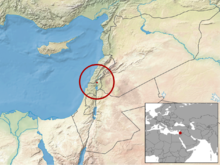Hula painted frog
| Hula painted frog | |
|---|---|
 |
|
| The recently discovered female specimen | |
| Scientific classification | |
| Kingdom: | Animalia |
| Phylum: | Chordata |
| Class: | Amphibia |
| Order: | Anura |
| Family: | Alytidae |
| Genus: | Latonia |
| Species: | L. nigriventer |
| Binomial name | |
|
Latonia nigriventer (Mendelssohn & Steinitz, 1943) |
|
 |
|
| Synonyms | |
|
Discoglossus nigriventer Mendelssohn and Steinitz, 1943 |
|
Discoglossus nigriventer Mendelssohn and Steinitz, 1943
The Hula painted frog (Latonia nigriventer) is an amphibian and the only living member of the genus Latonia. It was thought to be extinct as a result of habitat destruction during the 1950s until the species was rediscovered in 2011. It is endemic to the Lake Hula marshes in Israel.
The draining of Lake Hula and its marshes in the 1950s was thought to have caused the extinction of this frog, along with the cyprinid fish Acanthobrama hulensis and cichlid fish Tristramella intermedia. Only five individuals had been found prior to the draining of the lake. Environmental improvements in the Hula reserve have been cited as a possible reason for the frog's reemergence.
The Hula painted frog has a dark belly with small white spots. It is colored ochre above with a rusty colour grading into dark olive-grey to greyish-black on the sides. Differences from the common painted frog (Discoglossus pictus) include its greater interocular distance, longer forelimbs, and a less projecting snout. The type specimen was an adult female with a body length of 40 millimetres (1.6 in)
Little is known about its history, because few specimens have been found by scientists. Two adults and two tadpoles were collected in 1940 and a single specimen was found in 1955. This would prove to be the last record of this species until 2011.
The four 1940 specimens were to be used as types, but the smaller, half-grown frog was eaten by the larger one in captivity. The latter eventually became the holotype (HUJZ Amphib. Discogl. 1) for the species' description and this or the individual collected in 1955 apparently is the only material remains of the species known today; the two tadpole paratypes (HUJZ Amphib. Discogl. 2 and 2a) appear to have been lost.
...
Wikipedia

